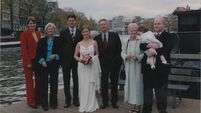Fog of War: The lies that lay behind WW1

REFLECTING on the horrors of World War I, 100 years on, it is hard to fathom that so many volunteered, apparently willingly, for what became such a catastrophic mass slaughter.
Men queued up in droves throughout the UK answering General Kitchener’s call “Britain needs you”.
An estimated 200,000 Irishmen, from north and south, enlisted to fight in the war, with 49,000 of those never to return.
It is important to acknowledge that there were likely to have been numerous complex reasons why people enlisted for the war including genuine patriotism, the belief that it was the right moral thing to do, a sense of camaraderie, a feeling of obligation towards fellow recruits, the promise of Home Rule (in the case of some Irishmen) the chance of getting clothed and fed properly every day and the promise that they would be home for Christmas dinner.
But what created this fervent ideology? One of the main reasons men were so influenced has to be the effect of the massive propaganda campaign waged by the governments and the established elites of the various countries involved.
This took many forms such as posters, postcards, public speeches, meetings, rallies, newspaper articles, cartoons, radio broadcasts, etc. A unity of purpose pervaded between the government, the military, media moguls and high-ranking members of the establishment in what can only be called a conspiracy of lies.
War journalist and critic Phillip Knightley has noted in regard to World War 1 that: “.... more deliberate lies were told than in any other period of history, and the whole apparatus of the state went into action to suppress the truth”.
One of the main protagonists of the war, British prime minister Lloyd George, admitted to CP Scott, editor of the Manchester Guardian in 1916 that: “If the people really knew [the truth] the war would be stopped tomorrow. But of course they don’t know and can’t know.”
As we commemorate World War 1, it is worth then reflecting on some of these substantial lies and try to comprehend why so many people signed up apparently so willingly.
Persuading ordinary people to fight in wars often relies on one key myth, i.e. that the enemy
is solely responsible for starting the war. All major powers in wars play this game. One of the greatest wartime myths of WW1 was that Germany was solely responsible for the war and thus had to be stopped at all cost.
From H.H. Asquith in 1914 saying: “And with whom does this responsibility rest? ... One Power, and one Power only, and that Power is Germany” to Lloyd George as late as August 1917, suggesting: “(We are fighting) to defeat the most dangerous conspiracy ever plotted against the liberty of nations, carefully, skillfully, insidiously, clandestinely planned in every detail with ruthless, cynical determination.”
This message was further propagated by the media moguls who had been promoted to powerful positions in government to conduct the propaganda war, such as Lord Northcliffe who said: “The whole situation of the Allies in regard to Germany is governed by the fact that Germany is responsible for the war”.
Arthur Ponsonby in his 1928 book Falsehood in War-time: Propaganda Lies of the First World War, through analysis of quotations both during and after the war, challenged the popular belief that Germany had sole responsibility for the war, and presented it for what it was; a wartime myth created to persuade ordinary people to fight.
Some of the pronouncements made after the war by members of the establishment on the real reasons for the war confirm this wartime myth.
A sombre Lloyd George noted in 1920: “The more one reads memoirs and books written in the various countries of what happened before August 1, 1914, the more one realises that no one at the head of affairs quite meant war at that stage. It was something into which they glided, or rather staggered and stumbled, perhaps through folly, and a discussion, I have no doubt, would have averted it.”
This represents quite a shift from his definite blame on Germany in his wartime statements.
Others in the ruling elites were even more explicit about the real causes of the war. Lord Cecil of Chelwood speaking in 1927 noted that: “No one could deny that the state of mind produced by armament competitions prepared the soil on which grew up the terrible plant which ultimately fruited in the Great War.”
There was also this classic from US President Woodrow Wilson who said in September 1919:
“Is there any man or woman let me say, is there any child who does not know that the seed of war in the modern world is industrial and commercial rivalry? ...This was an industrial and commercial war.”
This was the same President who claimed in 1917 that the US must enter the war because “the world must be made safe for democracy” understood quite well that it was to make it safe for the major western industrial powers — an incredible admission to make just one year after the war ended.
The entente powers, especially Britain, made much of the invasion of Belgium as the cause of the Great War. As Lloyd George noted on January 5, 1918: “The treaty obligations of Great Britain to that little land (Belgium) brought us into the war”.
Again Ponsonby is instructive here as he cogently refutes this fallacy and, supported by reliable quotes from British government ministers, posits that the real reason the British government went to war against Germany was because of its secret alliance with France and that it had little to do with Germany’s invasion of Belgium.
The false image of defending ‘plucky little Belgium’, however, was a powerful recruitment tool in both England and Ireland. As Ponsonby noted: “it was used to excite national enthusiasm”.
Of course the former barbarity of King Leopold’s forces in the Congo was conveniently not aired at this time.
In addition to blaming the enemy for starting the war the protagonists needed to portray the enemy as evil incarnate. Joshua D. Johnson of the Lloyd International Honours College, in a paper examining the propaganda used by both Germany and Britain, has written: “From the start ... Great Britain was forced to use its most powerful and persuasive propaganda weapon: the demonisation of the enemy. Germany also employed these tactics, but they were nothing in comparison to the flood of atrocity stories and cultural animosity that Great Britain (and later the USA) would produce.”
The German Kaiser was thus portrayed as a monster in human form in British posters and the media. John Jewell notes that: The Daily Mail of September 22, 1914 portrayed him in separate reports as a “lunatic”, “madman”, “barbarian”, “monster”, and “modern Judas”.
That’s a lot of imagery for one day!
There is also the case of a famous military dispatch, allegedly from the Kaiser, that referred to the British Expeditionary Force as the “contemptible little army”. This was never proven as originating from the Kaiser but the British establishment used it for propaganda purposes to create resentment throughout Britain.
Ponsonby notes that: “Churchill made great play with it in a recruiting speech at the London Opera House on 11th September 1914.”
This was all part of the propaganda used to create a hate figure for people to vent their anger against so they would be easily convinced to go to war. Ponsonby claims that Kaiser William 2 “was, and always had been, a tinsel figure-head of no account, with neither the courage to make a war nor the power to stop it” and who, at the end of the war, the entente powers were content to leave living peacefully in exile in Holland.
Again we witness contrasting attitudes being openly expressed in the post-war era as Lord Edward Grey, the wartime Foreign Minister, noted that: “If matters had rested with him (the Kaiser) there would have been no European War arising out of the Austro-Serbian dispute.”
So the Kaiser was a fine little chap after all and the demonising of him during the war was purely a necessary part of the propaganda machine needed to persuade a gullible and frightened population to prosecute the war.
The ordinary German soldier fared even worse from this type of fallacious portrayal in what is known as ‘atrocity propaganda’. The popular myth about the barbarity of German soldiers, which circulated particularly after the invasion of Belgium, was that they raped Belgium women and cut off the hands of their children.
This is also when the derogatory term ‘The Hun’ began to be used to describe German soldiers. Images depicting these supposed horrors were circulated around Britain and France but no evidence ever produced.
One image shows the Kaiser with an axe standing behind a chopping board, several severed hands on the floor, beckoning to a group of women to bring their children forward. Some of the children have had their hands cut off already.
There were many poster images produced depicting German soldiers engaged in similar acts of depravity, including impaling babies on their bayonets, replete with slogans in bold text such as ‘The Rape of Belgium’ or ‘Remember Belgium’. Stories abounded also about the handless Belgian child who was travelling around Britain and then to the America and even the far west.
It is not hard to imagine how such falsehoods, when depicted in graphic and lurid detail through widely distributed posters and newspapers, could impact on frightened populations in Britain and France.
The myth lived on well after the war. Ponsonby notes that as late as 1928 how a Liverpool poet, in a volume called A Medley of Song, wrote the following lines in a “patriotic” poem:
Ponsonby elaborates on many more atrocity stories of alleged German barbarity that were promulgated by British media and politicians, including accounts of cutting off women’s breasts and raping daughters and wives in front of their husbands then killing the entire family, including babies, with bayonets.
A Baptist minister in Sheffield preached from the pulpit that a young 12-year-old Belgian girl who had made it to Sheffield “had had her nose cut off and her stomach ripped open by the Germans, but she was still living and getting better.”
Huge damage was done by these false atrocity stories, which were officially sanctioned by the British establishment through the publication of the infamous Report of the Committee on Alleged German Outrages, better known as “The Bryce Report” (named after James Bryce, the head of the committee). The report was eventually discredited but not before it had been translated into 30 languages by 1915 and had, in Joshua D. Johnson’s words: “stoked the righteous indignation of the allied populace and dramatically increased recruitment for the cause of defeating Germany.”
Such atrocity stories were investigated and almost all disproved, the case of the girl with her missing nose and stomach being rebuked by the Belgian consul, in a letter of March 11, who wrote: “Although I have heard of a number of cases of Belgian girls being maltreated in one way and another, I have on investigation not found a particle of truth in one of them, and I know of no girl in Sheffield who has had her nose cut off and her stomach ripped open. I have also investigated cases in other towns, but have not yet succeeded in getting hold of any tangible confirmation.”
A serious rebuttal of alleged German barbarity in Belgium came from four American journalists who wrote:
“To let the truth be known, we unanimously declare the stories of German cruelties, from what we have been able to observe, were untrue. After having been with the German army for two weeks, and having accompanied the troops for over one hundred miles, we are not able to report one single case of undeserved punishment or measure of retribution.
“We are neither able to confirm any rumours as regards maltreatment of prisoners and non-combatants. Having been with the German troops through Landen, Brussels, Nivelles, Buissière, Haute-Wiherie, Merges-le-Château, Sorle-sur-Sambre, Beaumont, we have not the slightest basis for making up a case of excess.
“We found numerous rumours after investigation to be without foundation. German soldiers paid everywhere for what they bought, and respected private property and civil rights. We found Belgian women and children after the battle of Buissière to feel absolutely safe. A citizen was shot in Merbes-le-Chateau, but nobody could prove his innocence.
“Refugees, who told about cruelties and brutalities, could bring absolutely no proof. The discipline of the German soldiers is excellent; no drunkenness. The Burgomaster of Sorle-sur-Sambre voluntarily disclaimed all rumours of cruelties in that district. For the truth of the above we pledge our word of honor as journalists.”
The journalists were Roger Lewis, Associated Press; Irwin Cobb, Saturday Evening Post, Philadelphia Public Ledger, Philadelphia; Harry Hansen, Chicago Daily News, Chicago; James, O’Donnell Bennett,
Chicago Tribune; John T. McCutcheon, Chicago Tribune, Chicago.”
The deep irony of all these untruths directed at German soldiers about alleged atrocities in Belgium is that actual cases of multiple raping of women and the severing of children’s hands, the latter actually recorded in photos, were those carried out by the agents of King Leopold 2 of Belgium as part of his rape and plunder of the African Congo over 20 years previously.
Another infamous wartime catastrophe, and a case of the entente powers being less than truthful with the facts, would extend the war to involve America and bring a whole new impetus to the allied propaganda machine.

A German U-boat sank the Lusitania off the southern Irish coast on May 7, 1915, apparently without any warning, killing 1,198 people, including 128 Americans on board. It was a horrific loss of civilian life and a blatant attack on an apparently defenceless civilian ship.
However, according to David Swanson, “the Lusitania was in fact “packed with American-made war material, including ten-and-a-half-tons of rifle cartridges, 51 tons of shrapnel shells, and a large supply of gun cotton, not to mention 67 soldiers of the 6th Winnipeg Rifles. The German Embassy in New York had published a warning in New York newspapers prior to its sailing that because the ship was carrying war supplies and soldiers it would be subject to possible attack.
Multiple lies were told about the true nature of the cargo after the sinking. In particular the fact that there were soldiers, armaments and ammunition on board was denied by US government officials including by President Woodrow Wilson, causing his secretary of state to resign.
There has been much speculation also that the ship sank quicker than it would otherwise have done because of secondary explosions caused by the lethal cargo, carried in defiance of American laws, thus contributing to the huge loss of life.
The key issue however is the way that the pro-war lobby in America manipulated the event in order to convince the population of the necessity of joining the war effort in Europe. As Ponsonby notes: “The very crucial political significance of the catastrophe, however, gave it special propaganda value in inflaming popular indignation, especially in America. Here obviously was the necessary lever at last to bring America into the war.”
Posonby also reveals how the event was used by the Entente Powers to stir up hate against the Germans, this time using a pre-wartime photograph with a misleading caption.
He notes: “A photograph was taken in Berlin of a crowd before the royal palace on July 13, 1914 (before the outbreak of war). This was reproduced in Le Monde Illustré, August 21, 1915, with the heading: “ENTHOUSIASME ET JOIE DE BARBARES“, with an explanation that it was a demonstration to celebrate the sinking of the Lusitania.”
This was one of many examples of photographs being either doctored or labelled inaccurately to create an illusion of barbarity.
Editors and owners of the major newspapers were charged with various aspects of Government war propaganda.
By 1918 Beaverbrook, the owner of Express newspapers, was Minister of Information, while Robert Donald, editor of the Daily Chronicle, was director of propaganda in neutral countries. The journalists at the war front were effectively treated as members of the army and were there to report on heroic deeds, to protect the generals from criticism and to aid recruitment at home. Some of the copy sent back was so ludicrously misleading and offensive.
Jewell quotes correspondent Herbert Russell thus on the catastrophic first day of the battle of the Somme: “Good progress into enemy territory. British troops were said to have fought most gallantly and we have taken many prisoners. So the day is going well for Great Britain and France.”
In reality, while the British army made minor territorial gains, the battle on July 1, 1916, was the worst day in its history with a casualty figure of c. 60,000. Journalists, editors, and newspaper owners, in connivance with the government, played down this mass carnage.
Life was made very difficult for those who tried to expose the real aims of the warmongers and arms manufacturers, and relate instead the true horrors of the war.
In America Woodrow Wilson introduced the Espionage Act once war was declared in 1917. It was designed to stifle any dissent and soon there were 1,000 anti-war campaigners imprisoned including the outspoken Eugene V. Debs, sentenced to ten years after he made the following observations in a speech:
“Wars throughout history have been waged for conquest and plunder ... and that is war, in a nutshell. The master class has always declared the wars; the subject class has always fought the battles.”
All of the major powers, Germany included, used lies and propaganda in order to both frighten and stir up their populations. It worked. The major effect of this was a massive increase in recruitment as hundreds of thousand of men marched off to be slaughtered.
Johnson notes that: “The emergence of propaganda in World War One set the standard for wars to follow, and sanctioned the deception of civilians and the demonization of the enemy. In the end, the point is not really the differences between German and British propaganda, but in their similarities. Both nations were driven by a philosophy that marked an important moment in cultural history: the opening of a vast gap between the “official truth” and the undisclosed reality of war.”
This is useful in understanding the role propaganda played but Johnson misses a key analysis here, that of the difference between who was telling the lies and whom they were being told to.
Far from being a “war to end all wars” or a “victory for democracy”, World War I was a military disaster and a catastrophe for humankind, all premised on big establishment lies. Caring little about humanity, establishment powers sent millions to be slaughtered and also used the war as a testing ground for new mechanised techniques of mass killing that encouraged huge profiteering through the armaments industry.
Should we commemorate the war? Absolutely, yes! But the lies told to mask what Johnson calls the ‘undisclosed reality of war’ commemorations. The commemorations should also be a time to expose the lies that have been told of successive wars since then, and more importantly — of wars currently waged.
In Ireland we should commemorate the memory of every individual, especially the 49,000 Irishmen, who died in World War 1. But, while recognising that many joined for different reasons, we should look back in anger at the way all those soldiers were stirred up, frightened, made to feel guilty if they refused to join up, cajoled by fantasies of great glory, manipulated and lied to — by army generals, politicians, clergymen, industrialists and media moguls — while forced to fight their fellowmen and die horrible deaths in muddy trenches and scorched battlefields for what was ultimately one big lie, orchestrated for the benefit of the few at the expense of the many.
















